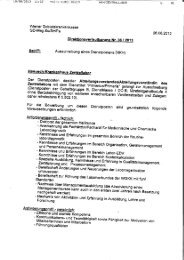Diagnosis and Classification of Diabetes Mellitus
Diagnosis and Classification of Diabetes Mellitus
Diagnosis and Classification of Diabetes Mellitus
You also want an ePaper? Increase the reach of your titles
YUMPU automatically turns print PDFs into web optimized ePapers that Google loves.
<strong>Diagnosis</strong> <strong>and</strong> <strong>Classification</strong><br />
develops gradually <strong>and</strong> at earlier stages is<br />
<strong>of</strong>ten not severe enough for the patient to<br />
notice any <strong>of</strong> the classic symptoms <strong>of</strong><br />
diabetes. Nevertheless, such patients are<br />
at increased risk <strong>of</strong> developing macrovascular<br />
<strong>and</strong> microvascular complications.<br />
Whereas patients with this form <strong>of</strong><br />
diabetes may have insulin levels that<br />
appear normal or elevated, the higher<br />
blood glucose levels in these diabetic<br />
patients would be expected to result in<br />
even higher insulin values had their b-cell<br />
function been normal. Thus, insulin secretion<br />
is defective in these patients <strong>and</strong><br />
insufficient to compensate for insulin resistance.<br />
Insulin resistance may improve<br />
with weight reduction <strong>and</strong>/or pharmacological<br />
treatment <strong>of</strong> hyperglycemia but is<br />
seldom restored to normal. The risk <strong>of</strong><br />
developing this form <strong>of</strong> diabetes increases<br />
with age, obesity, <strong>and</strong> lack <strong>of</strong> physical activity.<br />
It occurs more frequently in women<br />
with prior GDM <strong>and</strong> in individuals with<br />
hypertension or dyslipidemia, <strong>and</strong> its frequency<br />
varies in different racial/ethnic subgroups.<br />
It is <strong>of</strong>ten associated with a strong<br />
genetic predisposition, more so than is the<br />
autoimmune form <strong>of</strong> type 1 diabetes. However,<br />
the genetics <strong>of</strong> this form <strong>of</strong> diabetes<br />
are complex <strong>and</strong> not clearly defined.<br />
Other specific types <strong>of</strong> diabetes<br />
Genetic defects <strong>of</strong> the b-cell. Several<br />
forms <strong>of</strong> diabetes are associated with<br />
monogenetic defects in b-cell function.<br />
These forms <strong>of</strong> diabetes are frequently<br />
characterized by onset <strong>of</strong> hyperglycemia<br />
at an early age (generally before age 25<br />
years). They are referred to as maturityonset<br />
diabetes <strong>of</strong> the young (MODY) <strong>and</strong><br />
are characterized by impaired insulin secretion<br />
with minimal or no defects in insulin<br />
action. They are inherited in an<br />
autosomal dominant pattern. Abnormalities<br />
at six genetic loci on different chromosomes<br />
have been identified to date.<br />
The most common form is associated<br />
with mutations on chromosome 12 in a<br />
hepatic transcription factor referred to as<br />
hepatocyte nuclear factor (HNF)-1a. A<br />
second form is associated with mutations<br />
in the glucokinase gene on chromosome<br />
7p <strong>and</strong> results in a defective glucokinase<br />
molecule. Glucokinase converts glucose<br />
to glucose-6-phosphate, the metabolism<br />
<strong>of</strong> which, in turn, stimulates insulin secretion<br />
by the b-cell. Thus, glucokinase<br />
serves as the “glucose sensor” for the<br />
b-cell. Because <strong>of</strong> defects in the glucokinase<br />
gene, increased plasma levels <strong>of</strong> glucose<br />
are necessary to elicit normal levels<br />
<strong>of</strong> insulin secretion. The less common<br />
forms result from mutations in other transcription<br />
factors, including HNF-4a,<br />
HNF-1b, insulin promoter factor (IPF)-<br />
1, <strong>and</strong> NeuroD1.<br />
Point mutations in mitochondrial<br />
DNA have been found to be associated<br />
with diabetes <strong>and</strong> deafness The most<br />
common mutation occurs at position<br />
3,243 in the tRNA leucine gene, leading<br />
to an A-to-G transition. An identical<br />
lesion occurs in the MELAS syndrome<br />
(mitochondrial myopathy, encephalopathy,<br />
lactic acidosis, <strong>and</strong> stroke-like syndrome);<br />
however, diabetes is not part <strong>of</strong><br />
this syndrome, suggesting different phenotypic<br />
expressions <strong>of</strong> this genetic lesion.<br />
Genetic abnormalities that result in<br />
the inability to convert proinsulin to insulin<br />
have been identified in a few families,<br />
<strong>and</strong> such traits are inherited in an<br />
autosomal dominant pattern. The resultant<br />
glucose intolerance is mild. Similarly,<br />
the production <strong>of</strong> mutant insulin molecules<br />
with resultant impaired receptor<br />
binding has also been identified in a few<br />
families <strong>and</strong> is associated with an autosomal<br />
inheritance <strong>and</strong> only mildly impaired<br />
or even normal glucose metabolism.<br />
Genetic defects in insulin action. There<br />
are unusual causes <strong>of</strong> diabetes that result<br />
from genetically determined abnormalities<br />
<strong>of</strong> insulin action. The metabolic abnormalities<br />
associated with mutations <strong>of</strong><br />
the insulin receptor may range from<br />
hyperinsulinemia <strong>and</strong> modest hyperglycemia<br />
to severe diabetes. Some individuals<br />
with these mutations may have acanthosis<br />
nigricans. Women may be virilized <strong>and</strong><br />
have enlarged, cystic ovaries. In the past,<br />
this syndrome was termed type A insulin<br />
resistance. Leprechaunism <strong>and</strong> the Rabson-<br />
Mendenhall syndrome are two pediatric<br />
syndromes that have mutations in the<br />
insulin receptor gene with subsequent<br />
alterations in insulin receptor function<br />
<strong>and</strong> extreme insulin resistance. The former<br />
has characteristic facial features <strong>and</strong> is<br />
usually fatal in infancy, while the latter is<br />
associated with abnormalities <strong>of</strong> teeth <strong>and</strong><br />
nails <strong>and</strong> pineal gl<strong>and</strong> hyperplasia.<br />
Alterations in the structure <strong>and</strong> function<br />
<strong>of</strong> the insulin receptor cannot be<br />
demonstrated in patients with insulinresistant<br />
lipoatrophic diabetes. Therefore,<br />
it is assumed that the lesion(s) must reside<br />
in the postreceptor signal transduction<br />
pathways.<br />
Diseases <strong>of</strong> the exocrine pancreas. Any<br />
process that diffusely injures the pancreas<br />
can cause diabetes. Acquired processes<br />
include pancreatitis, trauma, infection, pancreatectomy,<br />
<strong>and</strong> pancreatic carcinoma.<br />
With the exception <strong>of</strong> that caused by<br />
cancer, damage to the pancreas must be<br />
extensive for diabetes to occur; adrenocarcinomas<br />
that involve only a small<br />
portion <strong>of</strong> the pancreas have been associated<br />
with diabetes. This implies a mechanism<br />
other than simple reduction in<br />
b-cell mass. If extensive enough, cystic fibrosis<br />
<strong>and</strong> hemochromatosis will also<br />
damage b-cells <strong>and</strong> impair insulin secretion.<br />
Fibrocalculous pancreatopathy may<br />
be accompanied by abdominal pain radiating<br />
to the back <strong>and</strong> pancreatic calcifications<br />
identified on X-ray examination.<br />
Pancreatic fibrosis <strong>and</strong> calcium stones<br />
in the exocrine ducts have been found at<br />
autopsy.<br />
Endocrinopathies. Several hormones<br />
(e.g., growth hormone, cortisol, glucagon,<br />
epinephrine) antagonize insulin action.<br />
Excess amounts <strong>of</strong> these hormones<br />
(e.g., acromegaly, Cushing’s syndrome,<br />
glucagonoma, pheochromocytoma, respectively)<br />
can cause diabetes. This generally<br />
occurs in individuals with<br />
preexisting defects in insulin secretion,<br />
<strong>and</strong> hyperglycemia typically resolves<br />
when the hormone excess is resolved.<br />
Somatostatinoma- <strong>and</strong> aldosteronoma-induced<br />
hypokalemia can cause<br />
diabetes, at least in part, by inhibiting<br />
insulin secretion. Hyperglycemia generally<br />
resolves after successful removal <strong>of</strong><br />
the tumor.<br />
Drug- or chemical-induced diabetes.<br />
Many drugs can impair insulin secretion.<br />
These drugs may not cause diabetes by<br />
themselves, but they may precipitate diabetes<br />
in individuals with insulin resistance.<br />
In such cases, the classification is<br />
unclear because the sequence or relative<br />
importance <strong>of</strong> b-cell dysfunction <strong>and</strong> insulin<br />
resistance is unknown. Certain toxinssuchasVacor(aratpoison)<strong>and</strong><br />
intravenous pentamidine can permanently<br />
destroy pancreatic b-cells. Such<br />
drug reactions fortunately are rare. There<br />
are also many drugs <strong>and</strong> hormones that<br />
can impair insulin action. Examples include<br />
nicotinic acid <strong>and</strong> glucocorticoids.<br />
Patients receiving a-interferon have been<br />
reported to develop diabetes associated<br />
with islet cell antibodies <strong>and</strong>, in certain<br />
instances, severe insulin deficiency. The<br />
list shown in Table 1 is not all-inclusive,<br />
but reflects the more commonly recognized<br />
drug-, hormone-, or toxin-induced<br />
forms <strong>of</strong> diabetes.<br />
Infections. Certain viruses have been<br />
associated with b-cell destruction. <strong>Diabetes</strong><br />
occurs in patients with congenital rubella,<br />
although most <strong>of</strong> these patients<br />
S66 DIABETES CARE, VOLUME 35, SUPPLEMENT 1, JANUARY 2012 care.diabetesjournals.org




